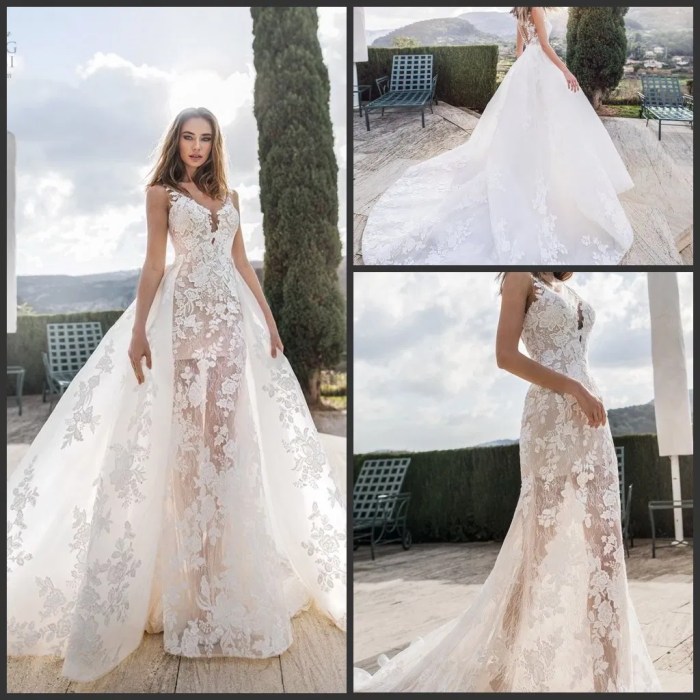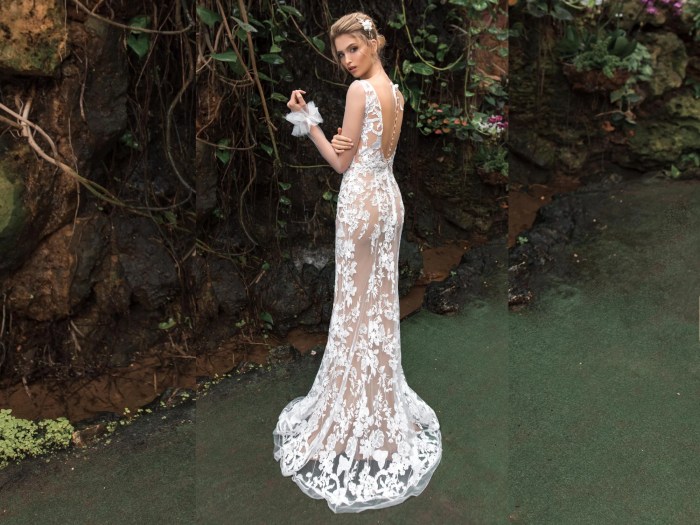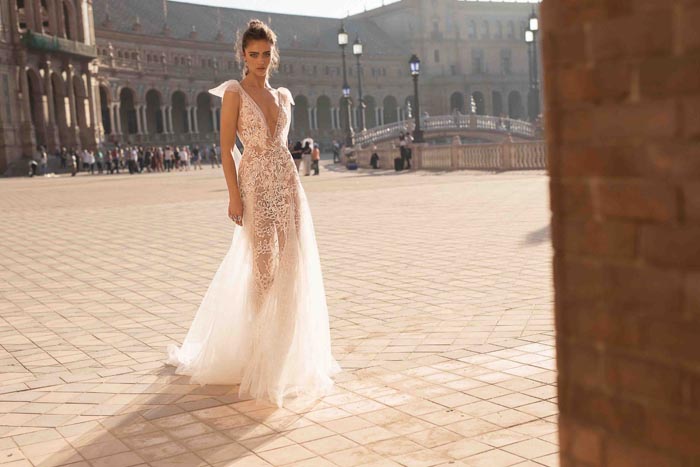Design Trends in See-Thru Wedding Dresses: See Thru Wedding Dresses

Source: made-in-china.com
See thru wedding dresses – See-through wedding dresses have evolved significantly, reflecting broader fashion trends and shifting societal norms. This section explores the design trends, fabric choices, and stylistic evolutions within this niche bridal market.
See-Thru Fabric Types in Wedding Dresses
Various sheer fabrics contribute to the unique aesthetic of see-through wedding gowns. The choice of fabric significantly impacts the overall look, feel, and level of transparency.
| Fabric Type | Transparency Level | Drape | Common Applications |
|---|---|---|---|
| Lace | Variable, depending on the pattern and density | Structured, can hold its shape | Illusion necklines, sleeves, and overlays; intricate detailing |
| Tulle | High, often layered for varying opacity | Soft, flowing, delicate | Skirts, overlays, creating ethereal effects |
| Chiffon | Moderate to high, depending on the weight | Lightweight, fluid, drapes beautifully | Flowing skirts, sleeves, and overlays; creates a romantic feel |
| Organza | High, often used in combination with other fabrics | Stiff, crisp, holds its shape well | Structured overlays, creating dimension and texture |
Evolution of See-Thru Wedding Dress Styles
Over the past decade, see-through wedding dresses have transitioned from subtly revealing designs to more daring and creatively intricate styles. Initially, illusion necklines and backs were popular, gradually leading to more extensive use of sheer fabrics in the skirt and bodice.
Illusion Necklines and Back Details, See thru wedding dresses
Designers cleverly incorporate illusion elements to create a balance between modesty and allure. Illusion necklines, often crafted from lace or tulle, offer a hint of skin while maintaining a sophisticated look. Similarly, illusion backs add a touch of drama and elegance, showcasing intricate detailing or delicate embroidery.
For example, a gown might feature a high neckline with delicate lace appliqués creating an illusion of coverage while subtly revealing the skin beneath. Alternatively, a low back could be adorned with intricate lace or embroidered tulle, adding a touch of drama and visual interest without being overly revealing.
Impact of Current Fashion Trends
Current fashion trends, such as bohemian and minimalist aesthetics, significantly influence see-through wedding dress designs. Bohemian styles often incorporate flowing fabrics, intricate embroidery, and natural elements, creating a relaxed yet romantic look. Minimalist designs, on the other hand, prioritize clean lines, simple silhouettes, and understated elegance, often using sheer fabrics to create a sense of airy sophistication.
The Psychology of See-Thru Wedding Dresses
The choice of a see-through wedding dress is often a reflection of the bride’s personality, confidence, and personal style. This section explores the psychological and cultural aspects influencing this choice.
Symbolism and Cultural Connotations
The symbolism of revealing attire in wedding ceremonies varies across cultures and religions. In some contexts, it can symbolize purity and innocence, while in others, it may represent sensuality and confidence. The level of transparency and the overall design significantly influence the interpretation of the dress.
Modesty and Sensuality in See-Thru Dress Designs
The perceived level of modesty and sensuality in a see-through wedding dress is subjective and depends on various factors, including the fabric type, level of transparency, and the overall design of the gown. A dress with strategically placed lace appliqués might be perceived as more modest than one with extensive sheer panels. The silhouette of the dress and the overall aesthetic also play a significant role in shaping perceptions.
Transparency’s Impact on Bride’s Confidence

Source: etsystatic.com
The level of transparency in a wedding dress can significantly affect a bride’s confidence and self-expression. A bride who feels comfortable and confident in her body might opt for a more revealing design, while another might prefer a more modest style. The choice is ultimately a personal one, reflecting the bride’s individual preferences and comfort levels.
Factors Influencing the Choice of Wedding Dress
Several factors influence a bride’s decision to choose a see-through wedding dress versus a more traditional one. These factors include personal style, body confidence, cultural background, religious beliefs, and the venue and time of year of the wedding. A bride’s personal aesthetic and the overall theme of the wedding also play a significant role in this decision.
Practical Considerations for See-Thru Wedding Dresses
Wearing a see-through wedding dress requires careful planning and consideration. This section addresses practical aspects such as undergarments, care, and weather considerations.
Choosing Appropriate Undergarments
- Select seamless, nude-colored undergarments to avoid showing through the sheer fabric.
- Consider shapewear to create a smooth silhouette under the dress.
- Choose undergarments that match the level of transparency of the dress; for example, a heavily embellished dress might require less coverage than a more delicate one.
- Test your undergarments with the dress beforehand to ensure they are invisible under different lighting conditions.
Caring for a See-Thru Wedding Gown
- Follow the care instructions provided by the designer or manufacturer.
- Dry clean the dress to avoid damaging the delicate fabrics.
- Store the dress in a breathable garment bag to protect it from dust and light.
- Avoid harsh chemicals or abrasive cleaning methods.
- If storing long-term, consider professional preservation services.
Challenges and Solutions for Different Weather

Source: com.au
Wearing a see-through wedding dress in various weather conditions requires careful planning. In hot weather, lightweight fabrics like chiffon or tulle are preferable, and the bride may consider wearing a light shawl or wrap for added coverage. In cold weather, layering with a warm coat or jacket is essential, while choosing a slightly more opaque fabric might be beneficial.
Venue and Time of Year Considerations
The choice of a see-through wedding dress should complement the venue and time of year. A beach wedding might call for a lighter, more flowing style, while an indoor winter wedding might be better suited to a more structured, potentially layered design. The overall ambiance of the venue and the time of day should also be considered.
Marketing and Selling See-Thru Wedding Dresses
Marketing see-through wedding dresses effectively requires a strategic approach that highlights their unique selling points and targets the right audience. This section explores marketing strategies and visual presentation.
Marketing Campaign for See-Thru Dresses
A successful marketing campaign would emphasize the romantic, ethereal, and modern aspects of see-through gowns. The campaign would use evocative language, focusing on the feeling of confidence and elegance the dresses evoke. It would highlight the craftsmanship and the luxurious fabrics used in the creation of these gowns.
Effective Visual Marketing Materials
High-quality photographs and videos are crucial. One example could be a close-up shot showcasing the intricate lace detailing on an illusion neckline, highlighting the craftsmanship and artistry. Another could be a full-length shot of a bride gracefully moving in a flowing tulle gown, capturing the ethereal beauty and movement of the fabric.
Targeting Different Bridal Demographics
Marketing strategies should vary depending on the target audience. Younger brides might respond well to social media campaigns showcasing modern and edgy styles, while older brides might prefer more classic and elegant presentations. Targeted advertising on platforms frequented by each demographic is essential.
Importance of Proper Fitting and Alterations
Proper fitting and alterations are paramount for see-through dresses. Marketing materials should emphasize the importance of professional fittings and alterations to ensure a perfect fit and flawless appearance. This aspect adds value and builds trust with potential customers.
Ethical Considerations in See-Thru Wedding Dress Design
The ethical implications of using sheer fabrics and revealing designs in wedding attire are multifaceted and require careful consideration. This section explores ethical sourcing, sustainability, and cultural sensitivity.
Ethical Implications of Sheer Fabrics and Revealing Designs
The ethical considerations center around the potential for exploitation in the production of fabrics and the cultural appropriateness of revealing attire. The use of sustainable and ethically sourced materials is crucial, ensuring fair labor practices and environmental responsibility throughout the production process.
Appropriateness in Religious or Cultural Contexts
The appropriateness of see-through dresses varies significantly across religious and cultural contexts. What might be considered acceptable in one culture might be deemed inappropriate in another. Designers and retailers should be sensitive to these cultural nuances and avoid designs that could be offensive or disrespectful.
Sustainable and Ethically Sourced Fabrics
Examples of sustainable and ethically sourced fabrics include organic cotton lace, recycled polyester tulle, and responsibly sourced silk. Using these materials reduces the environmental impact and promotes fair labor practices within the fashion industry.
Impact of Fast Fashion
Fast fashion contributes to the overconsumption and waste associated with see-through wedding dresses. The emphasis on low-cost, quickly produced items often comes at the expense of ethical labor practices and environmental sustainability. Promoting slower fashion and durable, high-quality gowns is crucial for mitigating this impact.
Common Queries
What are the best fabrics for see-thru wedding dresses?
Lace, tulle, and chiffon are popular choices, each offering varying levels of transparency and drape. The best fabric depends on the desired level of sheerness and the overall aesthetic.
How do I ensure my see-thru dress is comfortable?
Proper undergarments are crucial. Consider a nude-toned bodysuit or strategically placed shapewear to avoid any unwanted exposure while maintaining comfort and support.
Can I wear a see-thru dress in any weather?
Consider the fabric’s weight and the weather conditions. Lighter fabrics may be unsuitable for colder or windy days. Layering with a shawl or jacket can provide warmth and protection.
Are see-thru dresses appropriate for all wedding venues?
The appropriateness depends on the venue’s formality and your personal style. A more formal venue may call for a less sheer design, while a more relaxed setting might allow for more creative interpretations.
